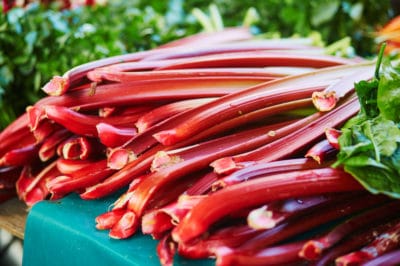Growing Rhubarb
Rhubarb prefers cool climates – USDA Zones 3 to 7. However it can also be grown in warmer areas if you grow it from seeds and treat it as an annual. Plant crowns in early spring or late fall when plants are dormant. It needs rich, fertile soil that is high in nitrogen and plenty of water. Mulch to add organic matter, keep down weeds and conserve moisture.
Rhubarb Varieties
Most rhubarb has red to pink stalks, although a few are green. Here are some popular varieties:
- Colorado Red – cherry red inside and out.
- Victoria – dark raspberry red at base; green closer to leaves.
- German Wine – green stems speckled with pink; sweeter than most.
- Sunrise – pink stalks, thicker than other varieties.
- Riverside Giant – cold hardy, thick green stalks.
Spring Harvesting
Rhubarb is one of the earliest plants you can harvest. Once the stalks have reached 10 inches long, you can begin to cut them. The actual time of harvest will vary according to your climate. In colder areas, you may not be able to start harvesting until April or May, while in warmer areas, you may have rhubarb in March.
Summer Harvest
Rhubarb will continue to pump out new stalks for most of the spring and summer. You can extend your harvest with well-established plants. Technically, you could keep harvesting until fall, but the plant does need to store energy for winter. It’s best to stop cutting in late June or July, but if your plant is healthy and several years old, you could pick sparingly until August.
New Plantings
A perennial, rhubarb needs time to become established. Rush the harvesting and your plants will never do as well. For the first two years, let your plants grow. Don’t cut any stalks and pay careful attention to nutrition and care. Harvest lightly the third spring. After that you can harvest a full crop each year. Rhubarb can live for many years.
Annual Rhubarb
In warm climates, it’s best to treat rhubarb as an annual. Obtain crowns in late summer and put them in cold storage for six weeks; plant in late fall. Harvest once stalks are 10 inches tall. You can also sow seeds indoors in early spring and plant out when they are three to four inches tall. To harvest, cut the 10-inch stalks with a sharp knife.
